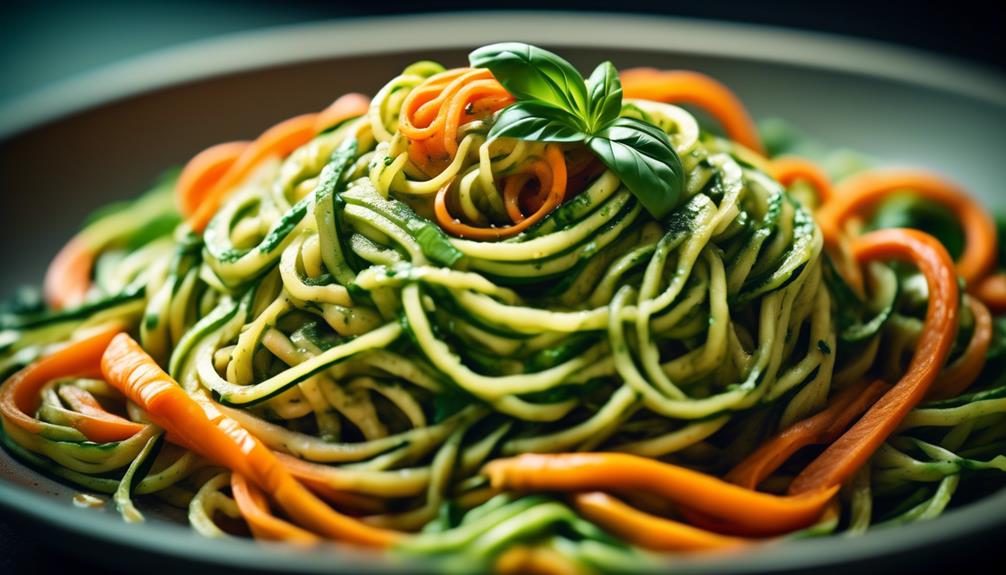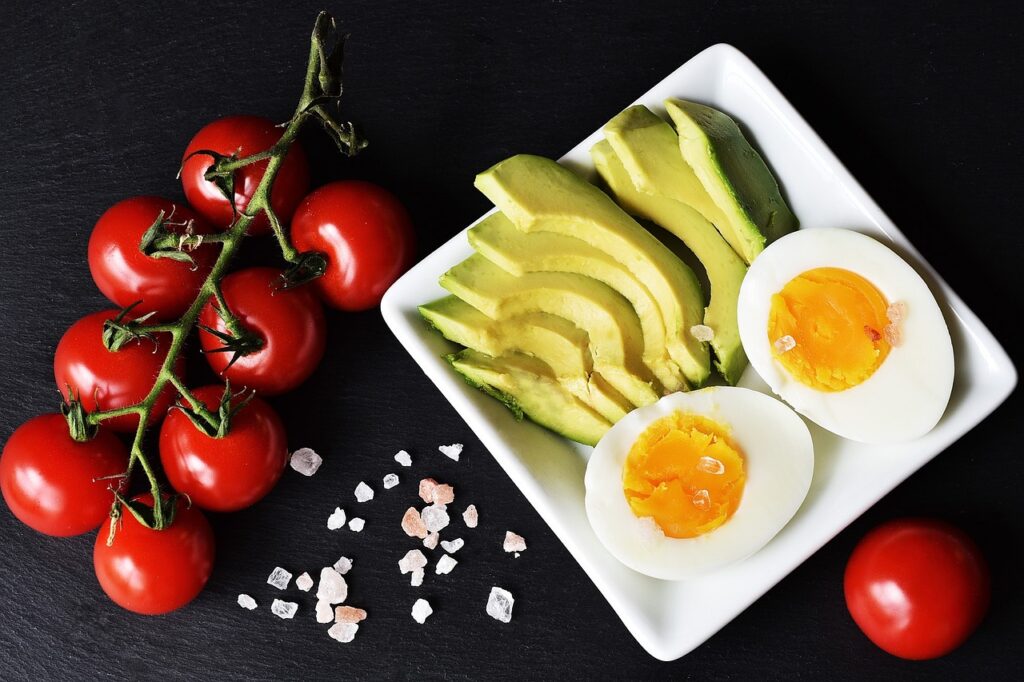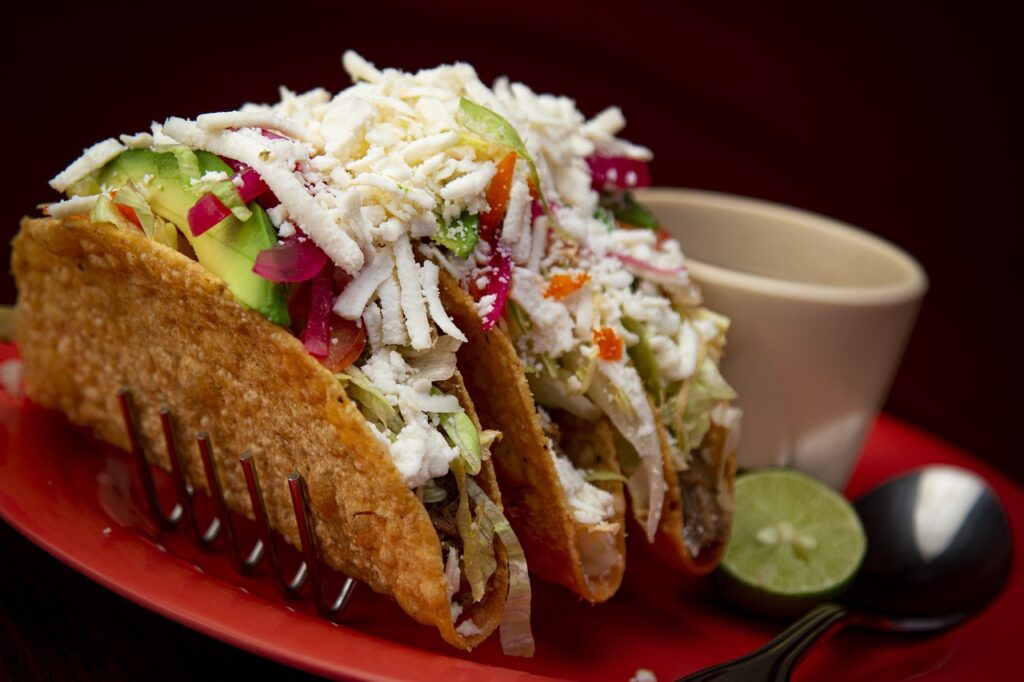Looking for keto-friendly pasta options as a vegetarian can feel like searching for a needle in a haystack. With so many delicious carb-loaded pastas out there, it may seem like your options are limited. But fear not, because there are actually several keto-friendly pasta alternatives that are perfect for vegetarians.
These options not only satisfy your pasta cravings, but also keep you on track with your low-carb lifestyle. So, get ready to discover some mouthwatering options that will make you forget all about traditional pasta.
Zucchini Noodles
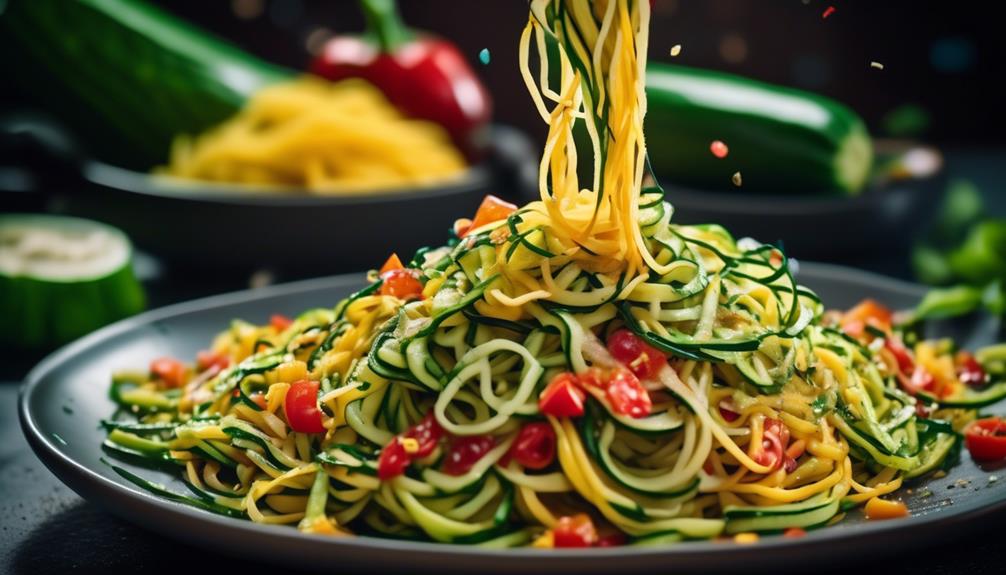
To enjoy a keto-friendly pasta alternative, zucchini noodles, also known as zoodles, can be a nutritious and satisfying option for vegetarians. Zucchini noodles are made by spiralizing zucchini into long, thin strands that resemble traditional pasta. Not only are zoodles low in carbs and calories, but they're also packed with vitamins, minerals, and fiber.
When it comes to cooking zucchini noodles, there are a few techniques you can try. One popular method is sautéing them in a pan with a little bit of oil until they're tender but still have a slight crunch. This cooking technique helps to bring out the natural flavors of the zucchini and gives the noodles a nice texture. Another option is to blanch the zoodles in boiling water for just a couple of minutes, then immediately transfer them to an ice bath to stop the cooking process. This method is great if you prefer a softer texture.
As for sauce options, zucchini noodles can be paired with a variety of keto-friendly sauces. A classic choice is a simple marinara sauce made with tomatoes, garlic, and herbs. You can also try a creamy Alfredo sauce made with heavy cream and parmesan cheese. For a lighter option, toss the zoodles with lemon juice, olive oil, and fresh herbs. The possibilities are endless!
Shirataki Noodles
If you're looking for another keto-friendly pasta alternative, consider trying Shirataki noodles as a nutritious option that pairs well with vegetarian dishes. Made from the root of the konjac plant, Shirataki noodles are low in carbs and calories, making them an excellent choice for those following a keto diet.
Here are three cooking methods for Shirataki noodles and recipe ideas to inspire your next meal:
- Rinse and Boil: Start by rinsing the noodles under cold water to remove any odor. Then, boil them for 2-3 minutes to improve their texture. Once cooked, toss them with your favorite low-carb sauce, such as marinara or pesto, and add vegetables like spinach, mushrooms, or bell peppers for a satisfying meal.
- Stir-Fry: Heat a non-stick pan over medium heat and add the noodles without oil. Stir-fry them for a few minutes to remove excess moisture. Next, add your choice of vegetables, such as broccoli, carrots, and snap peas, along with some soy sauce or tamari for flavor. Continue stir-frying until the vegetables are tender, and the noodles are heated through.
- Cold Salad: Shirataki noodles can also be enjoyed cold in refreshing salads. After rinsing the noodles, combine them with diced cucumbers, cherry tomatoes, feta cheese, olives, and a light vinaigrette dressing. Add some fresh herbs like mint or basil for extra flavor.
With these cooking methods and recipe ideas, you can easily incorporate Shirataki noodles into your vegetarian keto diet and enjoy a satisfying pasta-like experience without the guilt.
Spaghetti Squash
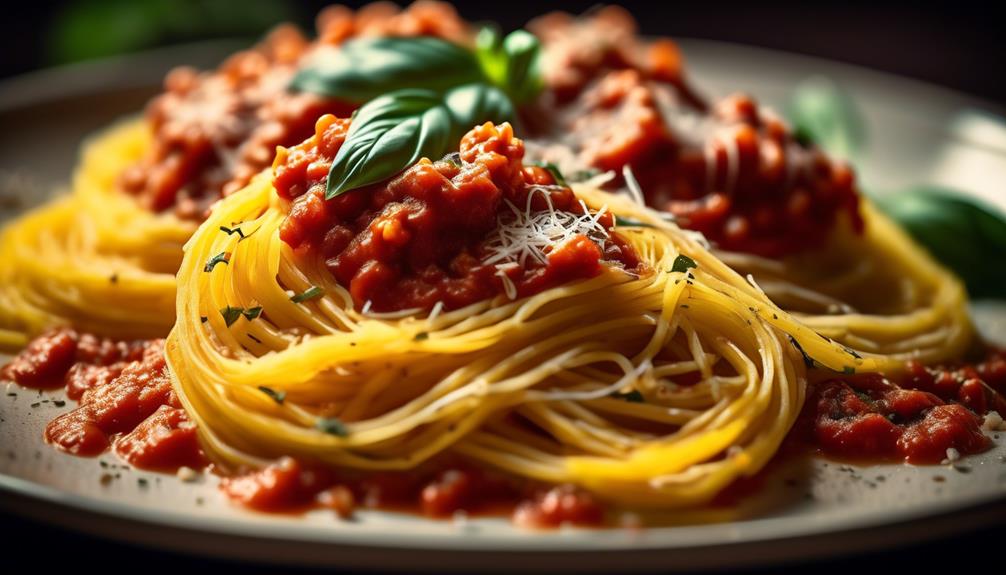
Spaghetti squash is a versatile and nutritious vegetable that can be a great substitute for traditional pasta in keto-friendly vegetarian meals. This low-carb and gluten-free option isn't only delicious but also packed with essential nutrients. One of the major benefits of spaghetti squash is its low calorie and carbohydrate content, making it suitable for those following a keto diet.
When it comes to preparing spaghetti squash, there are numerous recipes to choose from. One popular option is to roast the squash and use a fork to scrape out the flesh, which naturally separates into spaghetti-like strands. This can then be topped with a variety of keto-friendly sauces, such as marinara made from fresh tomatoes or a creamy alfredo sauce made with cauliflower.
Nutritionally, spaghetti squash is a rich source of vitamins A and C, as well as potassium and fiber. These nutrients support a healthy immune system, promote good digestion, and help maintain optimal blood pressure levels. Additionally, spaghetti squash contains antioxidants, which can help reduce inflammation in the body.
Incorporating spaghetti squash into your keto-friendly vegetarian meals provides a tasty alternative to traditional pasta while offering an array of nutritional benefits. So, why not give it a try and explore the many delicious spaghetti squash recipes available?
Cauliflower Rice
Cauliflower rice is a nutritious and versatile alternative to traditional rice. It's low in carbs and calories, making it a great option for those following a keto diet.
You can make cauliflower rice by simply pulsing cauliflower florets in a food processor until they resemble rice grains.
Nutritional Benefits of Cauliflower
To fully appreciate the nutritional benefits of cauliflower, you must consider its versatility as a low-carb substitute for traditional rice. Here are three reasons why cauliflower rice is a great addition to your diet:
- Low in calories and carbohydrates:
Cauliflower rice is a fantastic option for those following a keto or low-carb diet. It contains significantly fewer calories and carbs compared to regular rice, making it an excellent choice for weight management.
- High in fiber and nutrients:
Cauliflower is packed with essential nutrients like vitamin C, vitamin K, and folate. It's also a great source of dietary fiber, which aids digestion and helps keep you feeling full for longer periods.
- Versatile in cooking:
Cauliflower rice can be prepared using various cooking methods, such as steaming, sautéing, or even baking. It can be used as a base for stir-fries, salads, or as a side dish to accompany your favorite protein.
Incorporating cauliflower rice into your recipes not only allows you to enjoy a tasty and satisfying meal but also provides you with the added nutritional benefits of this versatile vegetable.
Cooking Methods for Cauliflower Rice
If you're ready to explore the various ways to cook cauliflower rice, you'll be delighted by the range of options available.
Cauliflower rice is a versatile and healthy alternative to traditional rice, and there are several cooking techniques you can use to enhance its flavor and texture.
One popular method is sautéing, where you cook the cauliflower rice in a pan with a little oil or butter until it becomes tender.
Another option is steaming, which helps retain the nutrients and gives the rice a light and fluffy texture.
You can also try roasting cauliflower rice in the oven for a delicious, nutty flavor.
Additionally, you can experiment with different seasonings and spices to create flavor variations, such as adding garlic, herbs, or even soy sauce for an Asian-inspired twist.
With these cooking techniques and flavor variations, you can enjoy cauliflower rice in a variety of delicious and satisfying ways.
Recipe Ideas Using Cauliflower Rice
For a delicious and low-carb meal option, try incorporating cauliflower rice into your recipes. This versatile ingredient can be used in a variety of ways, allowing you to enjoy your favorite dishes while keeping your carbohydrate intake in check. Here are three recipe ideas using cauliflower rice:
- Cauliflower Fried Rice: Start by sautéing cauliflower rice with your favorite vegetables, such as bell peppers, carrots, and peas. Add soy sauce, sesame oil, and garlic for savory flavor. You can also add scrambled eggs or tofu for extra protein.
- Cauliflower Rice Stir-Fry: Heat a pan with some oil and stir-fry cauliflower rice with a medley of colorful vegetables like broccoli, snap peas, and mushrooms. Season with ginger, garlic, and a splash of low-sodium soy sauce or tamari for a tasty and healthy stir-fry.
- Cauliflower Rice Pilaf: Sauté cauliflower rice with diced onions and garlic until they become tender. Add vegetable broth and your choice of herbs and spices, such as thyme, parsley, and black pepper. Simmer until the liquid is absorbed, and you'll have a flavorful and satisfying pilaf.
With these cooking techniques and flavor variations, you can create delicious cauliflower rice dishes that are both nutritious and satisfying.
Cabbage Noodles
Cabbage noodles, a versatile and low-carb option, can be a delicious substitute for traditional pasta in your keto-friendly vegetarian dishes. When it comes to cooking techniques for cabbage noodles, there are a few options to consider.
One method is sautéing the noodles in a pan with some olive oil or butter until they become tender. This technique brings out the natural sweetness of the cabbage and adds a nice caramelized flavor.
Another option is blanching the noodles in boiling water for a few minutes until they're al dente. This method helps to soften the cabbage while retaining a bit of crunchiness.
Now, let's compare different types of cabbage noodles. Napa cabbage, also known as Chinese cabbage, is a popular choice for making noodles. It has a mild and delicate flavor, making it a great base for various sauces and seasonings.
Savoy cabbage, on the other hand, has a slightly stronger flavor and a crinkly texture that holds up well in stir-fries and soups.
Red cabbage, with its vibrant color, adds a pop of visual appeal to your dishes and has a slightly sweeter taste compared to other varieties.
Eggplant Lasagna Sheets

Eggplant lasagna sheets are a delicious and keto-friendly alternative to traditional pasta, providing a flavorful and nutrient-rich base for your vegetarian lasagna dishes. Here are three reasons why you should consider using eggplant lasagna sheets in your cooking:
- Nutritional value: Eggplants are low in carbs and calories, making them a perfect choice for those following a keto diet. They're also a good source of dietary fiber, potassium, and antioxidants. By using eggplant lasagna sheets instead of regular pasta, you can increase your intake of essential nutrients while keeping your carb count low.
- Cooking methods: There are various ways to prepare eggplant lasagna sheets for your vegetarian lasagna dishes. One popular method is to grill or roast the eggplant slices to enhance their natural flavors. Another option is to lightly sauté them in olive oil for a softer texture. Regardless of the cooking method you choose, eggplant lasagna sheets add a unique taste and texture to your dish.
- Versatility: Eggplant lasagna sheets can be used in a variety of vegetarian lasagna recipes. Whether you prefer a classic tomato and cheese lasagna or a more creative combination of vegetables and herbs, eggplant lasagna sheets provide a sturdy base that holds up well to layers of sauce, cheese, and other ingredients. Their mild flavor also allows them to complement a wide range of flavors and seasonings.
Incorporating eggplant lasagna sheets into your vegetarian lasagna dishes not only adds a keto-friendly twist, but also provides you with a nutritious and delicious meal option. Explore different cooking methods and experiment with various flavors to create your own unique lasagna masterpiece.
Tofu Shirataki Noodles
To continue exploring keto-friendly pasta options for vegetarians, let's now turn our attention to Tofu Shirataki Noodles. These noodles are made from tofu and the root of the konjac plant, also known as the elephant yam. They're incredibly low in carbs and calories, making them a great choice for those following a ketogenic diet.
Tofu Shirataki noodles are a versatile ingredient that can be used in a variety of dishes. They work well in stir-fries, soups, and even pasta dishes. There are many tofu shirataki noodle recipes available online that can help you incorporate them into your meals.
One of the main health benefits of tofu shirataki noodles is their low calorie and carbohydrate content. A serving of these noodles typically contains less than 20 calories and just a few grams of carbs. They're also a good source of fiber, which can help promote feelings of fullness and aid in digestion.
Additionally, tofu shirataki noodles are gluten-free and vegan-friendly, making them suitable for those with dietary restrictions. They're a great alternative to traditional pasta for anyone looking to reduce their carb intake while still enjoying a satisfying meal.
Konjac Noodles
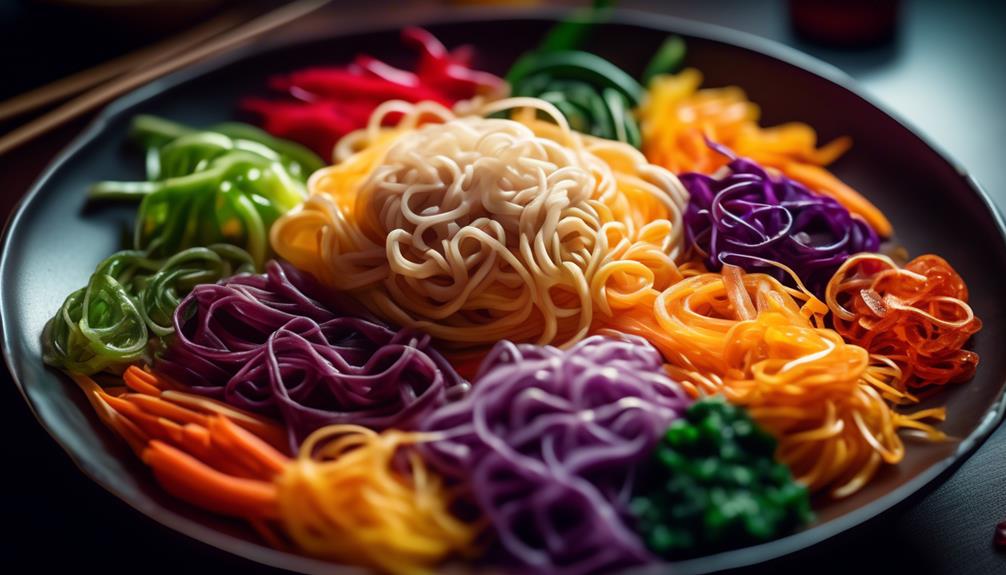
Konjac noodles, also known as shirataki noodles, are a low-carb and calorie-free pasta alternative that can be enjoyed by vegetarians following a keto diet. Made from the konjac plant, these noodles are rich in glucomannan, a type of dietary fiber known for its ability to promote feelings of fullness and aid in weight loss.
Here are some cooking methods for konjac noodles and recipe ideas to incorporate them into your vegetarian keto meals:
- Boiling: To cook konjac noodles, simply drain and rinse them thoroughly, then boil them for a few minutes until they become tender. This helps remove any potential odor or bitterness.
- Stir-frying: Konjac noodles can be stir-fried with your favorite vegetables, such as bell peppers, broccoli, and mushrooms. Add some soy sauce or tamari for flavor and top with sesame seeds or chopped peanuts for added crunch.
- Soup: Konjac noodles are a great addition to soups and stews. You can use them in place of regular noodles in recipes like vegetable noodle soup or keto-friendly pho. The noodles soak up the flavors of the broth, making each spoonful delicious and satisfying.
With these cooking methods and recipe ideas, you can enjoy the benefits of konjac noodles while sticking to your vegetarian keto diet. Incorporate them into your meals for a guilt-free pasta experience that won't derail your health goals.
Black Bean Pasta
Looking for a keto-friendly pasta option as a vegetarian? Black bean pasta might just be the answer. Not only is it low in carbs, but it's also packed with nutritional benefits.
Black beans are a great source of protein and fiber, making this pasta a satisfying and nutritious choice.
To cook black bean pasta, simply follow the instructions on the package, but be mindful not to overcook it to maintain its texture and flavor.
Nutritional Benefits of Black Bean Pasta
Black Bean Pasta offers a range of nutritional benefits that make it a great choice for vegetarians on a keto diet. Here are three reasons why you should consider adding this pasta to your meals:
- High in Protein: Black bean pasta is a great source of plant-based protein, containing around 15 grams per serving. This is important for vegetarians who may struggle to meet their protein needs on a keto diet.
- Rich in Fiber: This pasta is also packed with fiber, with about 15 grams per serving. Fiber helps to promote feelings of fullness, regulate blood sugar levels, and support a healthy digestive system.
- Low in Carbohydrates: Black bean pasta is low in carbohydrates, making it a suitable option for those following a keto diet. It contains only around 15 grams of net carbs per serving, allowing you to enjoy a pasta dish without worrying about exceeding your carbohydrate limit.
To cook black bean pasta, simply boil it in salted water for about 5-6 minutes until al dente.
Cooking Tips for Black Bean Pasta
For optimal cooking results, follow these helpful tips when preparing black bean pasta.
First, be sure to cook the pasta according to the package instructions. Black bean pasta tends to have a shorter cooking time compared to traditional wheat pasta, so make sure to keep an eye on it to prevent overcooking.
Secondly, when draining the pasta, rinse it with cold water to stop the cooking process and help maintain its firm texture. This step is crucial as overcooking can make the pasta mushy.
Lastly, when incorporating black bean pasta into a vegetarian keto diet, remember its benefits. Black bean pasta is low in carbohydrates and high in fiber, making it a great option for those following a keto diet. It also provides a good source of plant-based protein, which is essential for vegetarians.
Lentil Pasta
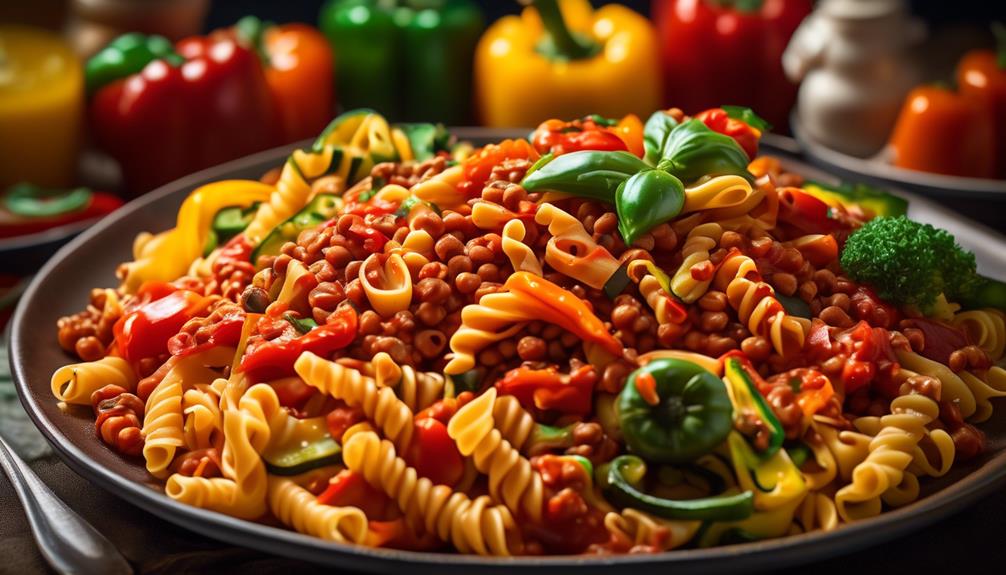
One popular option for vegetarians following a keto diet is lentil pasta, a nutritious and low-carb alternative to traditional pasta. Here are three reasons why lentil pasta is a great choice for those on a keto diet:
- Low in carbohydrates: Lentil pasta is made from ground lentils, which are naturally low in carbohydrates. Compared to regular pasta, lentil pasta contains significantly fewer carbs, making it a suitable option for those following a keto diet.
- High in protein and fiber: Lentils are a great source of plant-based protein and fiber. Lentil pasta retains these nutritional benefits, providing a satisfying and filling meal. The protein and fiber content in lentil pasta can help stabilize blood sugar levels and promote feelings of fullness, which is essential for managing weight on a keto diet.
- Versatile and delicious: Lentil pasta is available in various shapes and sizes, allowing you to enjoy your favorite pasta dishes while adhering to a keto diet. From spaghetti to penne, you can find lentil pasta options that mimic the texture and taste of traditional pasta. Additionally, lentil pasta pairs well with a variety of sauces and toppings, making it a versatile choice for keto-friendly meals.
Edamame Pasta
If you're looking for another nutritious and low-carb option to add to your keto-friendly pasta choices, consider trying edamame pasta. Edamame pasta is made from edamame beans, which are young soybeans. It's a great alternative to traditional pasta as it contains fewer carbs and more protein. When cooking edamame pasta, you can boil it in water for about 4-5 minutes or until it reaches your desired tenderness. You can also sauté it with some olive oil and vegetables for added flavor.
Edamame pasta offers several nutritional benefits. Firstly, it's a great source of plant-based protein, which is essential for building and repairing tissues in your body. It's also rich in fiber, which aids in digestion and helps you feel full for longer periods of time. Additionally, edamame pasta is low in fat and contains no cholesterol, making it a heart-healthy choice. It's also packed with vitamins and minerals, including iron, calcium, and vitamin C.
Almond Flour Pasta
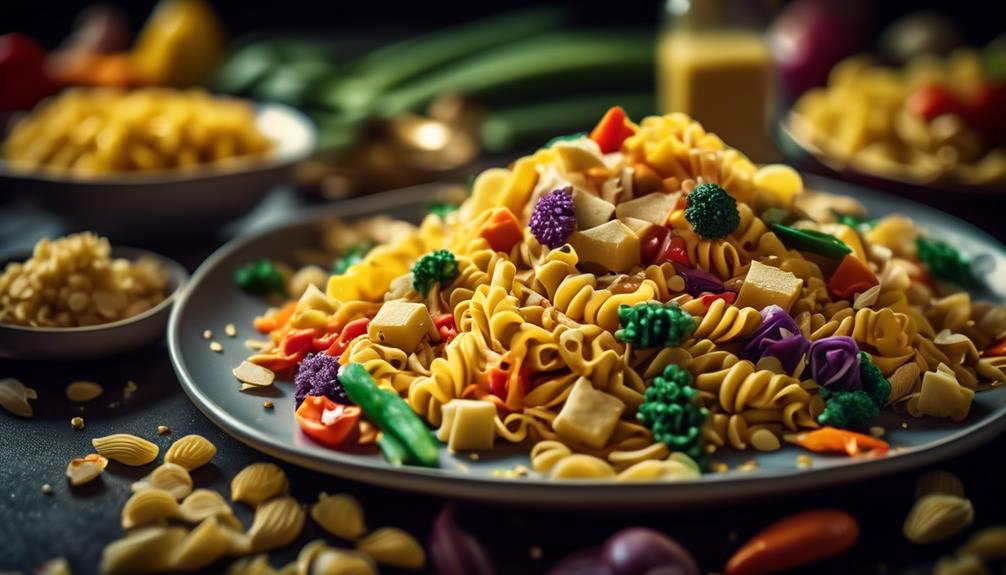
If you're looking for a keto-friendly pasta option, almond flour pasta is worth considering. Almond flour is low in carbs and high in healthy fats, making it a suitable choice for those following a ketogenic diet.
Additionally, almond flour pasta can be cooked in a similar way to traditional pasta, making it a convenient and satisfying option for vegetarians on a keto diet.
Health Benefits of Almond Flour
Almond flour, derived from finely ground almonds, offers a multitude of health benefits when used as a base for pasta. Here are three reasons why almond flour is a nutritious choice:
- Rich in nutrients: Almond flour is packed with essential nutrients such as vitamin E, magnesium, and protein. These nutrients contribute to overall health, supporting everything from immune function to muscle repair.
- Low in carbs and high in fiber: Almond flour is a great option for those following a low-carb or keto diet. It contains fewer carbs than traditional wheat flour and is rich in fiber, promoting feelings of fullness and aiding in digestion.
- Potential blood sugar management: Almond flour has a lower glycemic index compared to wheat flour, meaning it may cause a slower rise in blood sugar levels. This can be beneficial for individuals managing diabetes or looking to stabilize their blood sugar levels.
Incorporating almond flour into your pasta recipes can be a delicious way to enjoy its health benefits.
Cooking Tips for Almond Flour Pasta
To achieve perfect results when cooking almond flour pasta, follow these helpful tips.
Almond flour pasta is a great low-carb option for those following a ketogenic diet or looking for gluten-free alternatives.
First, make sure to cook the pasta in a large pot of well-salted boiling water. This will help prevent the pasta from sticking together and ensure even cooking.
Cooking time may vary, so it's important to taste the pasta for doneness.
Almond flour pasta tends to have a slightly nutty flavor, but you can enhance its taste by adding herbs, spices, or even cheese to the dough.
You can also experiment with different cooking techniques, such as sautéing the cooked pasta in olive oil or tossing it in a flavorful sauce.
Get creative and enjoy the delicious flavor variations that almond flour pasta has to offer.
Conclusion
In conclusion, there are many keto-friendly pasta options for vegetarians.
One interesting statistic is that a serving of zucchini noodles contains only 7 grams of carbs, compared to traditional pasta which can have around 40 grams of carbs per serving.
This visual representation highlights the significant difference in carbohydrate content, making zucchini noodles a great alternative for those following a keto diet.

